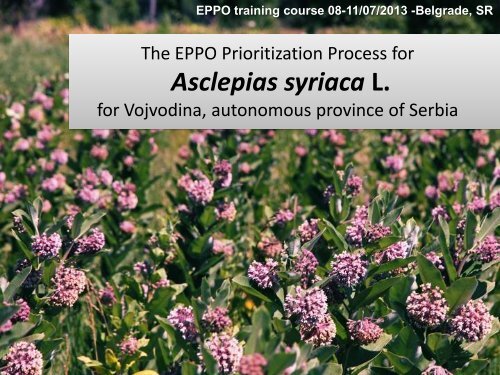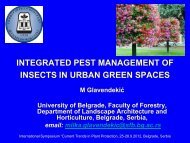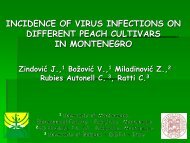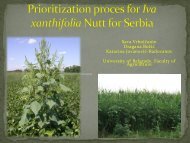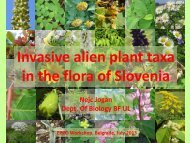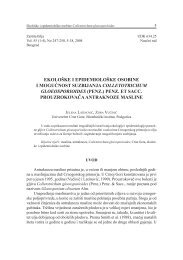Asclepias syriaca L
Asclepias syriaca L. - Izbis
Asclepias syriaca L. - Izbis
- No tags were found...
Create successful ePaper yourself
Turn your PDF publications into a flip-book with our unique Google optimized e-Paper software.
EPPO training course 08-11/07/2013 -Belgrade, SR<br />
The EPPO Prioritization Process for<br />
<strong>Asclepias</strong> <strong>syriaca</strong> L.<br />
for Vojvodina, autonomous province of Serbia
Taxonomic position:<br />
Magnoliopsida, Asclepidiaceae<br />
Synonyms (www.cabi.org):<br />
<strong>Asclepias</strong> cornuti Decne<br />
<strong>Asclepias</strong> intermedia Vail.<br />
<strong>Asclepias</strong> kansana Vail.<br />
<strong>Asclepias</strong> <strong>syriaca</strong> L. var. kansana<br />
(Vail) Palmer & Steyerm<br />
<strong>Asclepias</strong> tomentosum Opiz<br />
Common name (EN): Common<br />
milweed<br />
EPPO code: ASCSY
A.1 - Is the plant species known to be alien in the area<br />
under assessment?<br />
Yes<br />
<strong>Asclepias</strong> <strong>syriaca</strong> is native to North America<br />
and some areas of Canada<br />
Distribution of <strong>Asclepias</strong><br />
<strong>syriaca</strong> in the USA and<br />
Canada
A.2 - Is the plant species established in at least a part of<br />
the area under assessment?<br />
Yes<br />
According to Vrbničanin et al. (2008) plant is established in<br />
Bačka (west area of Vojvodina), and north part of Banat (east<br />
area of Vojvodina).
A.5 - How high is the spread potential of the plant in the<br />
area under assessment?<br />
High<br />
Level of uncertainty: low<br />
Seeds are spread by traffic vehicles, by the wind, which<br />
catches the fluffy part and carries the seed for long distances.<br />
Plant can spread quickly underground as well, by rhizomes.<br />
Parts of the rhizome is spread by human activities like<br />
movement of soils, or dispersed by farm machinery. <strong>Asclepias</strong><br />
<strong>syriaca</strong> occurs along the ponds and waterways, so there is<br />
possibility to spread by water (Wyatt et al. 1996; Wyatt et al.<br />
1993).
A.6 - How high is the potential negative impact of the<br />
plant on native species, habitats and ecosystems in the<br />
area under assessment?<br />
Medium<br />
Level of uncertainty: low<br />
<strong>Asclepias</strong> <strong>syriaca</strong> can be found<br />
along roadsides, railways, along<br />
the banks and flood plains of<br />
lakes, where it forms large,<br />
dense, persistent populations,<br />
but it is not high competitor,<br />
especially for light and soil<br />
resources like water and<br />
nutrients (Evetts and Burnside<br />
1975).
A.7 - How high is the potential negative impact of the plant<br />
on agriculture, horticulture or forestry in the area under<br />
assessment?<br />
High<br />
Level of uncertainty: low<br />
In the region of Vojvodina, <strong>Asclepias</strong> <strong>syriaca</strong> is less common in<br />
arable areas, but in the Subotica-Horgoš sands (north part of<br />
Vojvodina) plant was identified in both reclaimed and<br />
abandoned orchards and vineyards on sandy terrain and the<br />
arable land in the crop of spring barley, sunflower and rapeseed<br />
which has made tremendous damage (Dolmagić, 2010).
A.8 - How high are the potential additional impacts (e.g.<br />
on animal and human health, on infrastructures, on<br />
recreational activities, other trade related impacts such<br />
as market losses)?<br />
High<br />
Level of uncertainty: low<br />
The entire plant is considered<br />
poisonous. Turkey, chickens, sheep,<br />
goats, cattle, and horses are susceptible<br />
to milkweed toxins. Humans can also be<br />
poisoned by the plants. <strong>Asclepias</strong><br />
<strong>syriaca</strong> is also allergenic weed species<br />
and their milky sap can cause contact<br />
dermatitis to people with sensitive skin<br />
(Konstantinović et al. 2009; Anderson<br />
1999).
According to the ratings provided, the assessed<br />
species falls into the:<br />
- List of invasive alien plants
B.1 - Is the plant species internationally traded or are<br />
there other existing or potential international pathways?<br />
Yes<br />
<strong>Asclepias</strong> <strong>syriaca</strong> flower is a good source of honey for bees<br />
(Bhowmik and Bandeen, 1976), and it is believed that<br />
beekeepers are doing uncontrolled trade of seeds from<br />
neighbouring countries.
B.2 - Is the risk of introduction by these international<br />
pathways identified to be superior to natural spread?<br />
Yes<br />
International trade of <strong>Asclepias</strong> <strong>syriaca</strong> seeds and its<br />
deliberate seeding by beekeepers is more influential on<br />
species spread than natural one, because plat species is<br />
not high competitor.<br />
B.3 - Does the plant species still have a significant area<br />
suitable for further spread in the area under assessment?<br />
Small area suitable for further spread<br />
Research result of <strong>Asclepias</strong> <strong>syriaca</strong> distribution in Vojvodina<br />
(Vrbničanin et al. 2008), show that more than 40% of the<br />
potential suitable area is already occupied.
Outcome of the second part:<br />
A PRA is not considered a priority.
References<br />
• Anderson,W.P. (1999) Perennial Weeds: Characteristics and identifications of selected herbaceous species. Iowa State University<br />
Press.<br />
• Bhowmik, P.C., Bandeen, J.D. (1976) The biology of Canadian weeds. 19. <strong>Asclepias</strong> <strong>syriaca</strong> L. Can. J. Plant Sci. 56, 579-589.<br />
• Dolmagić, A. (2010) Preliminarna ispitivanja o mogućnosti suzbijanja ciganskog perja (<strong>Asclepias</strong> <strong>syriaca</strong> L.) - u usevu soje, Biljni lekar,<br />
38, 1, 42-49.<br />
• Evetts, L. (1977) Common milkweed--the problem. Proc. Annu. Meet. North. Cent. Weed Contr. Conf. 32:96-99.<br />
• Evetts, L. L. and O. C. Burnside. (1975) Effect of early competition on growth of common milkweed. Weed Science journal. 23, 1-3.<br />
• Igić, R., Boža, P., Anačkov, G., Vukov, D., Polić, D., Borišev, M. (2003) <strong>Asclepias</strong> <strong>syriaca</strong> L. (cigansko perje) u flori Vojvodine. Zbornik<br />
radova Prirodno-matematičkog fakulteta, serija za biologiju, Novi Sad, 31-32, 26-32.<br />
• Konstantinović B., Meseldžija ., Konstantinvić, Bo., Mandić, N ., Korać, M. (2009) Allergenic weed species and possibilities of their<br />
control. Biljni lekar, 37,6,634-640.<br />
• Reed, C.F. (1970) Selected weeds of the United States. Ag. Handbook 366. USDA, Washington, DC.<br />
• Stanković-Kalezić, R., Radivojević, Lj., Jovanović, V., Janjić, V., Šantrić, Lj. (2008) Adventivna vrsta <strong>Asclepias</strong> <strong>syriaca</strong> L. na području<br />
Pančevačkog rita. Acta herbologica 17,1, 95-103.<br />
• Tutin, T.G., Heywood, V.H., Burges, N.A., Moore, D.M., Valentine, D.H., Walters, S.M., Webb, D.A. (1972) Flora Europaea III.<br />
Cambridge University Press, Cambridge.<br />
• Vrbničanin, S., Malidža, G., Stefanović, L., Elezović, I., Stanković-Kalezić, R., Marisavljević, D, Radovanov-Jovanović, K., Pavlović, D.,<br />
Gavrić, M. (2008) Distribucija nekih ekonomski štetnih, invazivnih i karantinskih korovskih vrsta na području Srbije. Biljni lekar 5, 303-<br />
313.<br />
• Wyatt, R., (1996) More on the southward spread of common milkweed, <strong>Asclepias</strong> <strong>syriaca</strong> L. Bulletin of the Torrey Botanical Club 123,<br />
68–69.<br />
• Wyatt, R., Stoneburner A., Broyles, S.B. and Allison, J.R. (1993) Range Extension Southward in Common Milkweed, <strong>Asclepias</strong> <strong>syriaca</strong><br />
L.Bulletin of the Torrey Botanical Club 120,2, 177-179.<br />
• Yenish, P.J., A. Fry, T.A., Durgan B.R. and Wyse, D.L. (1996) Tillage Effects on Seed Distribution and Common Milkweed (<strong>Asclepias</strong><br />
<strong>syriaca</strong>) Establishment. Weed Science 44, 4, 815-820.


